|
|
Hanover

|
|
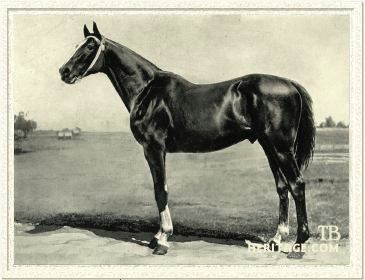 |
|
|
Hanover was a great racehorse who won at distances up to two miles, running his fourth season on a nerved foot, and a terrific sire who led the U.S. sire lists in four successive years, getting offspring who were top sprinters, great stayers, and classic distance winners.
He was in the first crop by Hindoo, one of the best racehorses ever to grace the American turf, and, although he proved to be a worthy successor to his sire on the track, Hanover's appearance was unlike his plain-headed, long-backed, minimally marked bay sire. At maturity, Hanover was taller than his barely 16-hand sire, with a lovely head and eye, a deep girth and good quarters; he was a bright red chestnut with a "slashing" blaze, tall front stockings and a shorter stocking on the off hind leg. His future owner, Phil Dwyer of Brooklyn Stable, who had owned and raced Hindoo, had a hard time believing he was a Hindoo foal when he saw Hanover as a yearling, but determined at that time to buy him, which he did soon thereafter, at Runnymede Farm's yearling sale in May of 1885. Dwyer, and his brother, Mike, collectively referred to as the Dwyer Brothers, had a racing stable in New York. They raced their horses hard, and generally without respite, as long as they held up. Hindoo managed to survive their regimen, until a tendon started giving him trouble towards the end of his four year old year. But Hanover, who did not have the protection of Hindoo's trainer James Rowe, who quit the Dwyers in dispute regarding overracing their horses, was not to be as lucky.
Hanover's dam was the unraced Bourbon Belle, a daughter of imported Bonnie Scotland. Her dam, Ella D., was a good race filly by Vandal, a solid racehorse and good sire who carried on the line of his sire, imported Glencoe. Hindoo was a Vandal grandson, thus Hanover was inbred 3 x 3 to Vandal.
Ella D.'s dam was Falcon, a sister to the beautiful and talented Grey Eagle, who had set an American record for two mile heats in a Louisville course sweepstakes in 1838. Their dam, Ophelia, whose breeding was tail-female back to Selima, was by Wild Medley. Wild Medley's dam was by a horse named Pensacola, about whom, according to the American Stud Book, where he is listed under "Imported Spanish Stallions," "Nothing is known...except that he was a tolerably good foal getter." Her dam was by the grey Lindsay's Arabian, also known as Ranger, about whom the American Stud Book quoted a long, involved story regarding his import from Morocco, via the West Indies, to Connecticut and later to Virginia.
|
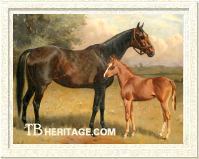
Rhoda B.'s descendants escaped the Jersey Act because she was in Ireland prior to its enactment
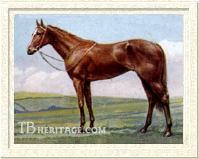
Hanover's grandson, Orby was considered a thoroughbred, despite his "stained" pedigree.
| |
On Hindoo's side of Hanover's pedigree was his dam, Florence, by the great American racehorse and sire Lexington, whose pedigree was considered "impure," since the female line pedigree of his grandsire, Timoleon, could not be traced in the General Stud Book. That, and the questions regarding Wild Medley's pedigree, were sufficient to bar Hanover's progeny from the General Stud Book when its compiler and publisher, Weatherby's, announced in 1913, that horses would not be allowed entry into the stud book unless their pedigrees could be traced "without flaw" to horses already accepted in earlier volumes of the GSB. Hanover wasn't, of course, the only horse affected--all Lexington descendants were disbarred, along with other families, both English and American, although it had no direct effect on the American Stud Book, and did not preclude these horses from racing in England.
There were, however, inconsistencies and narrow gaps of opportunity for some horses with "stained" pedigrees during the years this policy, known as the Jersey Act, was gradually hardening, starting around 1897. Thus, RHODA B. (1895), Hanover's daughter, imported into Ireland by Richard "Boss" Croker, was subsequently registered in the GSB, and qualified as a horse already admitted to the book prior to the 1913 enactment. So her Irish-bred son, Epsom Derby winner Orby, and his sister Rhodora, winner of the One Thousand Guineas, and their descendants were thoroughbreds, by the GSB's definition. |
None of Hanover's other descendants, however, were admitted, since none of them were imported into Great Britain within the window of opportunity. When Hanover's American grandson Sir Martin (1906, full brother to U.S. Triple Crown champion Sir Barton), through another daughter, LADY STERLING, was taken to England to run in the Derby, he was there considered a half-bred. Despite some good wins, including Epsom's Coronation Cup, as an official "half-bred," Sir Martin could not attract mares in Great Britain, and was returned to the U.S. This led to the curious case of Diapson (1921), who won the Goodwood Stakes, whose grandsire was Orby (out of Hanover's daughter RHODA B., accepted into the GSB) and whose dam's sire was Sir Martin (out of Hanover's daughter LADY STERLING, not admitted to the GSB), thus inbred 4 x 4 to Hanover. Because of Sir Martin, Diapson was considered a half-bred, even though Hanover came to his pedigree in identical removes via his daughters. Likewise, the 1914 Epsom Derby winner, Durbar II, whose daughter, Durban, produced the great French sire Tourbillon, was excluded from the GSB, because he was out of a Hanover grandaughter, Armenia.
Hanover on the Track
Hanover won 32 of his 50 starts in four years, and was out of the money only twice. Versatile and game, like his sire, he won at distances from 4 furlongs to 2 miles, often conceding great weights, and sometimes in the heaviest footing.
He only ran three times at age 2, shielded from the Dwyer brothers' manner of relentlessly overrunning their horses by his stablemate, Tremont, who was a precocious and wildly successful juvenile, one of the fastest American horses, ever. Tremont, by Hindoo's sire, Virgil, retired as champion of that season with thirteen straight victories, never headed -- he also, by the end of that year was burned out, and never raced again . Hanover's own first season ended three-for-three, with wins in the 6 furlong Hopeful Stakes, the July Stakes -- conceding 10 pounds to the rest of the field-- and the Sapling Stakes, beating Kingston. Unlike Tremont, he was lazy, and, according to James McLalughlin, his jockey in those races, "You had to ride him every step of the way or he was so lazy he'd loaf."
At age three, grown into himself, Hanover showed the brilliant speed and desire to win that marked the rest of his career. He was in the money in all but one of his twenty-seven starts, winning twenty of them, and placing second five times. Many of his wins were by great margins -- three lengths in the Brookdale Handicap, the 1-1/2 mile Belmont Stakes by 15 lengths, the Brooklyn Derby by 15 lengths, the 7 furlong Swift Stakes by 10 lengths (beating Kingston and the great race filly Firenzi), the 1-1/2 mile Coney Island Derby by 10 lengths. He raced continuously through the end of July that year, racking up fourteen successive wins in races in which he led from wire to wire, conceding weight in almost all of them. Then, on July 30, he lost for the first time, to a colt named Laggard, in the 1-1/4 mile Raritan Stakes, giving him 17 pounds. |
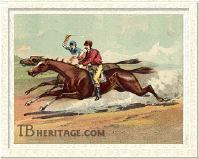
Hanover (forefront), was beaten by The Bard twice in his truncated third season.
| |
His grueling schedule for that year was still far from over. After an eleven day rest he was taken to the United States Hotel Stakes at Saratoga, and won the 1-1/2 mile race, and two days later won the Champion Stakes at the same distance from Firenzi and Volante. A week later he lost the Omnibus Stakes by a head to Laggard and Firenzi, conceding seven pounds to the winner, and lost again five days later in the 1-1/2 mile Choice Stakes, prompting the turf writer for Turf, Field and Farm to note: "Hanover's third defeat on Thursday of last week will probably at last open the eyes of his owners to the fact, which has been apparent to everyone else for a month, that their colt is not only out of condition, but that something is radically wrong...Hanover has this year been made to carry the whole of the Brooklyn Stable." |
|
The Dwyers continued to press the colt, and he ran eight more times that year, winning three times (the Second Special at Gravesend, the Breckenridge Stakes, and the 2 mile Dixie Stakes), but suffering further defeats from horses he had easily beaten earlier in the season, including Firenzi, who beat him in the 1-3/4 mile Jerome Stakes. |
|
Hanover's Race Record |
| Year |
Age |
Starts |
1st |
2nd |
3rd |
Unpl |
Earnings |
| 1886 |
2 |
3 |
3 |
0 |
0 |
0 |
$14,335 |
| 1887 |
3 |
27 |
20 |
5 |
1 |
1 |
87,632.50 |
| 1888 |
4 |
6 |
3 |
0 |
3 |
0 |
1,450 |
| 1889 |
5 |
17 |
9 |
6 |
1 |
1 |
15,470 |
| Total |
-- |
50 |
32 |
14 |
2 |
2 |
$118,887.50 |
| |
His four year old season began with a loss, by a length, in May, to The Bard, at Gravesend, followed by a loss in the Brookdale Handicap, and another beating by The Bard in the Brooklyn Cup. Clearly not his best, he was taken out of training, lame on his right forefoot. Eventually he was nerved, and mercifully given the rest of the year to heal.
|
Rather than retire him, the Dwyers brought him back at age 5 to run on a foot where he could no longer feel anything. He ran in 1889 seventeen times, winning nine of his races, and placing second six times. He was beaten three times in his first four starts, winning a modest seven furlong race at Gravesend, but losing the Brooklyn Jockey Club Handicap, where he was out of the money, the St. James Hotel Stakes, and the Brooklyn Cup. Dropped in class, he won three sweepstakes, and in towards the end of June was brought back to beat Firenzi in the Coney Island Cup, followed two days later by a win in the California Stakes. He won two more races, and lost five, that season, his wins in the Merchants' Stakes and the Express Stakes at seven furlongs, carrying 129 pounds in the latter race, giving away fourteen pounds to the second placed horse. His career ended in an ignominous second place to a modest racehorse, Volunteer, in a 5-1/2 furlong sweepstakes.
Hanover in the Stud
At the end of 1889, Hanover was purchased from the Dwyers for an undisclosed sum by Colonel Milton Young, who sent him to his McGrathiana Farm near Lexington, in Kentucky, where the good racehorse and sire Broomstick would be born a couple of years later. Highly successful at stud, he led the U.S. sires list for four successive years, 1895 through 1898. He was euthanized in March of 1899, age 15. Having survived a colic episode several months earlier, he was on the mend, but frustrated by his restricted diet due to the colic, he began to hammer his nerved foot in his stall. Unable to feel the pain, he fractured his coffin bone, which was followed by septicimea, and, with his condition worsening, he was humanely destroyed. He left some very good sons, one of which, HAMBURG, was outstanding, and excellent daughters who were the dams of such horses as U.S. Triple Crown champion Sir Barton, Epsom Derby winner Orby and One Thousand Guineas winner Rhodora. His youngsters' talents ran the gamut, from the top sprinter, ABE FRANK, to classic distance winners such as HALMA, to the good stayers DAVID GARRICK and BEN HOLLADAY.
|
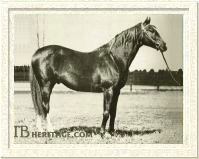
Outstanding racehorse and leading sire of 1905, Hamburg.
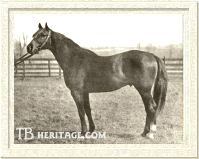
Yankee was a good racehorse and sire.
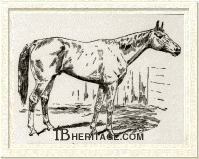
Staying handicapper Ben Holladay
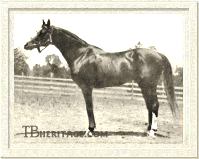
Handsel was another handsome son.
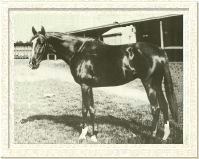
Halma won the Kentucky Derby. Photo courtesy Keeneland Library, used with permission.
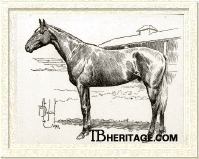
Abe Frank
| |
HAMBURG (1895), out of Lady Reel, a half-sister to Domino, was a brilliant two year old, good at three, and great at age four, with wins from 5 furlongs to the 2-1/4 mile Brighton Cup. He led the sires list in 1905, and among his many successful progeny were Dandelion (Dwyer Stakes, Travers Stakes, Suburban Handicap and many more); Burgomaster (Belmont Stakes, sire in South America); Artful (Futurity Stakes); Hamburg Belle (Futurity Stakes), and Frizette, ancestress of Seattle Slew and Mr. Prospector. While his daughters, such as Frizette, Jersy Lightning (dam of Regret), Biturica (dam of champion Maskette), and Lady Hamburg II (dam of Chicle and Dis Donc), were terrific producers, his sons were not particularly successful at stud, although Burgomaster made some mark after his export to South America.
YANKEE (1899) was closely related to Hamburg, being out of Domino's sister and Lady Reel's half-sister, the champion filly Correction. His best win was the Belmont Futurity; a big, top-heavy colt, he broke down early. He also failed to produce a good sire son, although son Joe Madden was a Belmont Stakes winner. His daughters were, however, good producers, including Continental, who produced the highly in-bred Infinite, who won the Nursery Handicap; Lover's Lane, bred in France, seen tail-female in the pedigree of Bates Motel and Our Emblem, among others; Yankee Sister, dam of the top racehorse Jack High (Metropolitan Handicap, Laurel Stakes and others); and Savannah, third dam of Sun Teddy and ancestress of a number of other good stakes winners. His best was probably The Nurse, who produced the excellent racing sisters Edith Cavell and Florence Nightingale (Family 23).
DAVID GARRICK (1897), from Peg Woffington, won the Great Trial Stakes at age 2, and then, purchased by Pierre Lorillard, failed to win in ten races at age 3 until the 2-1/4 mile Champion Stakes, in which he bested the good horse Ethelbert and others. Sent to England, he won the 2 -1/4 mile Chester Cup, and placed second for the Epsom Cup at 1-1/2 miles. Increasingly "savage," he became untrainable, and was shipped back to the U.S., where he was sold to Canada for stud. He was not a successful stallion.
BEN HOLLADAY (1893), out of Mollie L. by Longfellow, was a tough, long-running stayer. He took the Avondale Stakes and Telegraph Stakes at age three. His wins through age six included Morris Park's Municipal Handicap (14 furlongs) three times in succession, the Morris Park Handicap (16 furlongs) at age five, and Sheepshead Bay's Autumn Cup (16 furlongs) at ages four and six. He got several good broodmare daughters, including Ophirdale (1902, from Berriedale by Donovan), who established a successful line of runners in the U.S. that included the great Triple Crown winner Whirlaway (1938), the good stallion Reaping Reward (1934), and Belmont Stakes winner and sire Conquiestador Cielo (1979).
HANDSPRING (1893), from My Favorite by Rayon d'Or, a big chesnut colt marked like his sire, was a top two year old, winner of seven races. Despite his poor, shelly feet, he was good at three, the nemesis of Hastings; that year he won the Withers Stakes, beating Hastings, the Carlton and the Brooklyn Derby (later Dwyer Stakes). At age 4 he ran twice, winning once, but was too sore to place in his last race, the Brooklyn Handicap. He was later exported for stud duty.
Other good sons included the sprinter ABE FRANK (1899), sire of the great racemare Pan Zareta; HALMA (1892), winner of the Kentucky Derby and Latonia Derby and other top races, who was also exported for stud duty; BLACKSTOCK (1899), grandsire of the good racehorse Wise Counsellor (Laurel Stakes, Cincinnati Trophy, Queen City Handicap, International Special No. 1, and others), who became the Glencoe sire line's best hope for succession, but failed to produce a good sire son.
|
Hanover's son, THE COMMONER (1892), won 18 stakes races. He was out of Margerine, by Algerine, and brother to RHODA B. (1895), certainly Hanover's most famous producing daughter, being the dam of the ill-fated 1,000 Guineas winner Rhodora, and of Epsom Derby winner Orby, and through him, grandam of another Derby winner, Grand Parade. RHODA B. had been brought to Ireland as a yearling by Richard Croker, and ran only as a juvenile, in England, in his colors. She won Newmarket's Exning Plate, and was second in both Ascot's New Stakes and in the Great Two-Year-Old Plate at Sandown Park, and went unplaced in the Middle Park Plate and Manchester's Eglinton Nursery. In addition to Orby and Rhodora she bred five other surviving foals, all of them winners, including Jennico (1900), Rhododendron (1902), Alabama (1906), Clobern (1906) and Barnacullia (1911). Alabama went to Germany, where her female line survived: her great-grandaughter, Uberraschung (1941) became the dam of three high class winners: Tornado (1951, Austria Preis), Apollo (1953, Oesterreichisches Derby), and Formosa (1954, Austria Preis).
URANIA (1892), from the champion Mortemer filly Wanda, produced Armenia, the dam of Epsom Derby winner Durbar II, sire of the good racemare and great producer, Flambette and of the top French two year old filly, Durban, dam of Tourbillon and Banstar. Because Armenia was, unlike Orby, a U.S.-bred descendant of Hanover, Durbar II ran as a half-bred and, with no opportunities in England for stud, was sent to France, where he got his good daughters.
Other notable fillies by Hanover included TEA'S OVER (1893), grandam in tail-female of Hard Tack, and ancestress of Jamestown, John's Joy, Kentucky Derby winner Hoop Jr., and many another good racehorse; LADY STERLING (1899), dam of U.S. Triple Crown champion Sir Barton, and of Sir Martin, a top two year old in the U.S., and winner in England of the Durham Stakes and the Coronation Cup, among others, and of Lady Doreen, dam of champion filly Princess Doreen; Florrie (1893) ancestress of the top U.S. racehorse Market Wise (Jockey Club Gold Cup, Suburban Handicap and others); RETAINED II (1895), who, through daughter Hazel Burke, was second dam of two year old U.S. champion Eternal.
--Patricia Erigero
|
|
|
|

